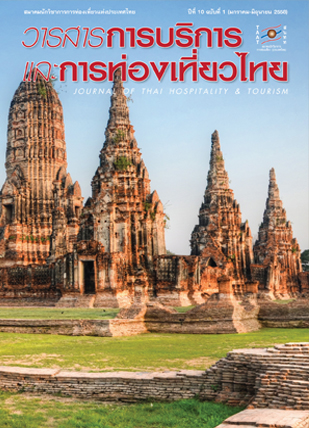การรับรู้ของนักท่องเที่ยวต่างชาติต่อแบรนด์ท่องเที่ยวไทยภายใต้แคมเปญ “AMAZING THAILAND”
Main Article Content
บทคัดย่อ
งานวิจัยนี้มีวัตถุประสงค์เพื่อศึกษาการรับรู้ภาพลักษณ์แบรนด์การท่องเที่ยวประเทศไทย ภายใต้แคมเปญ “Amazing Thailand” ในหมวดของ 7 Wonders of Amazing Thailand วิธีการวิจัยประกอบด้วย การวิจัยเชิงคุณภาพและเชิงปริมาณ เก็บข้อมูลจากนักท่องเที่ยวต่างชาติ 4 กลุ่มประเทศ ได้แก่ กลุ่มประเทศเอเชียกลุ่มประเทศภูมิภาคอเมริกา กลุ่มประเทศยุโรป และกลุ่มประเทศโอเชียเนีย รวม 420 ตัวอย่าง ผลการศึกษาพบว่า ความทรงจำของนักท่องเที่ยว แสดงให้เห็นถึงความหมายในมิติของวัฒนธรรมและงานเทศกาลความคุ้มค่าเงิน ด้านสถานที่ท่องเที่ยว คุณภาพของการบริการและผู้คน และทำเลที่ตั้งตามลักษณะทางภูมิศาสตร์ หากพิจารณาการรับรู้ของกลุ่มนักท่องเที่ยวเป้าหมายต่อความเป็นแบรนด์การท่องเที่ยวของประเทศไทยในมิติ 7 หมวด ภายใต้แคมเปญ Amazing Thailand พบว่า มีการรับรู้อย่างเด่นชัดในด้าน Nature: The Beauty of Natural Wonders ด้าน Beaches: Sun Surf and Serenity ด้าน Treasures: Land of Heritage and History และ ด้าน Thainess: The World’s Friendliness Culture ส่วนด้าน Health & Wellness: The Beauty of Wellness and Well-being ด้าน Trends: Your Senses with Unique Trends และด้าน Festivities: The Land of Year Round Festivities ยังอยู่ในภาพที่ไม่เด่นชัด เมื่อวิเคราะห์ตามกลุ่มนักท่องเที่ยวเป้ าหมาย พบว่า กลุ่มประเทศยุโรปและอเมริกา มีความชัดเจนในเรื่อง Beaches: Sun Surf and Serenity มากกว่ากลุ่มประเทศเอเชียและโอเชียเนีย ผลการศึกษา ยังแสดงถึงองค์ประกอบของแบรนด์การท่องเที่ยวประเทศไทย ในมิติของ ความเป็นต้นฉบับของแท้ (Authentic) ความง่ายในการเข้าถึง (Accessibility) และคุณภาพของบริการ (Quality of service) ที่มีผลต่อระดับความพึงพอใจของนักท่องเที่ยวกลุ่มเป้าหมาย ส่วนคุณภาพแหล่งจำหน่ายสินค้า คุณภาพสถานที่พัก ความง่ายในการเข้าถึง และความแตกต่างด้านอาหารและเครื่องดื่ม ยังเป็นปัจจัยสำคัญที่ส่งผลต่อระดับความภักดีของกลุ่มนักท่องเที่ยวเป้าหมายที่มีต่อแบรนด์การท่องเที่ยวประเทศไทย
Article Details
เอกสารอ้างอิง
[2] การท่องเที่ยวแห่งประเทศไทย. (2554). รายงานประจําปีการท่องเที่ยวแห่งประเทศไทยปี 2553. กรุงเทพฯ: การท่องเที่ยวแห่งประเทศ.
[3] กรมการท่องเที่ยว. (2554). สถิตินักท่องเที่ยว.วันที่ค้นข้อมูล 20 มิถุนายน 556, จากกรมการท่องเที่ยว http://tourism.go.th/2010/th/statistic/tourism.php?cid=30.
[4] กรมการท่องเที่ยว. (2554). สรุปสถิติการท่องเที่ยวประเทศไทยปี 2553. วันที่ค้นข้อมูล 18 พฤษภาคม 2555, จาก กรมการท่องเที่ยว http://tourism.go.th/2010/upload/filecenter/file/stat_2554/march/North.xls.
[5] บุญเลิศ จิตตั้งวัฒนา. (2548). การพัฒนาการท่องเที่ยวแบบยั่งยืน. กรุงเทพฯ: เพรสแอนด์ & ดีไซน์.
[6] สุดาวรรณ เตชะวิบูลย์วงศ์. (2543). กระบวนการสื่อสารเชิงสัญลักษณ์ผ่านสื่อมวลชนในอุตสาหกรรมการท่องเที่ยวยุคหลังสมัยใหม่ในโครงการ Amazing Thailand. กรุงเทพมหานคร: ฐานข้อมูลวิทยานิพนธ์ไทย.
[7] สํานักงานการท่องเที่ยวกระทรวงท่องเที่ยวและกีฬา. (2552). รายงานฉบับสมบูรณ์โครงการสํารวจพฤติกรรมการเดินทางของนักท่องเที่ยวภายในประเทศ. วันที่ค้นข้อมูล 18 พฤษภาคม 2555, จาก สํานักงานการท่องเที่ยวกระทรวงท่องเที่ยวและกีฬา. http://tourism.go.th/2010/th/statistic/tourism.php?cid=27.
[8] อรชร มณีสงฆ์, นฤมล กิมภากรณ์ และธันยา พรหมบุรมย์. (2553). พฤติกรรมของนักท่องเที่ยวชาวไทยต่อการท่องเที่ยวภาคเหนือตอนบนของประเทศไทย. เชียงใหม่: คณะบริหารธุรกิจมหาวิทยาลัยเชียงใหม่.
[9] Bernd H. Schmitt. (1999). Experiential marketing: How to get customers to sense, feel, think, act, relate. New York: Simon and Schuster.
[10 Bongkosh Ngamsom Rittichainuwat, Jeffrey A. Beck & Hailin Qu. (2002). Promotional Strategies and Travelers’ Satisfaction During the Asian Financial Crisis. Journal of Quality Assurance in Hospitality & Tourism. 3 (1-2), 109-124.
[11] European Institute for Brand Management. (1991). Aaker’s Brand Equity Model. Retrieved June 20, 2013, from the European Institute for Brand Management http://www.eurib.org/fileadmin/user_upload/Documenten/PDF/Merkmeerwaarde_ENGELS/s_Brand_equity_model_by_Aaker_EN_.pdf.
[12] Edith Smit, Fred Bronner, & Maarten Tolboom. (2007). Brand relationship quality and its value for personal contact. Journal of Business Research. 60(6), 627-633.
[13] Hong-bumm Kim and Woo Robbins, S. P. (2003). Organizational behavior. Englewood Cliffs. NJ: Prentice-Hall. 10th ed., 124.
[14] Roderick J. Brodie, James R.M. Whittome and Gregory J. Brush. (2008). Investigating the service brand: A customer value perspective. Journal of Business Research. 62(3), 345-355.
[15] Scott M. Davis. (2002). Brand Asset Management: Driving Profitable Growth through Your Brands. San Francisco, Josey Bass.


